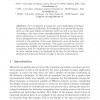Free Online Productivity Tools
i2Speak
i2Symbol
i2OCR
iTex2Img
iWeb2Print
iWeb2Shot
i2Type
iPdf2Split
iPdf2Merge
i2Bopomofo
i2Arabic
i2Style
i2Image
i2PDF
iLatex2Rtf
Sci2ools
BVAI
2007
Springer
2007
Springer
Recognition of Human Faces: From Biological to Artificial Vision
Face recognition is among the most challenging techniques for personal identity verification. Even though it is so natural for humans, there are still many hidden mechanisms which are still to be discovered. According to the most recent neurophysiological studies, the use of dynamic information is extremely important for humans in visual perception of biological forms and motion. Moreover, motion processing is also involved in the selection of the most informative areas of the face and consequently directing the attention. This paper provides an overview and some new insights on the use of dynamic visual information for face recognition, both for exploiting the temporal information and to define the most relevant areas to be analyzed on the face. In this context, both physical and behavioral features emerge in the face representation.
Artificial Intelligence | BVAI 2007 | Dynamic Visual Information | Face Recognition | Personal Identity Verification |
| Added | 12 Aug 2010 |
| Updated | 12 Aug 2010 |
| Type | Conference |
| Year | 2007 |
| Where | BVAI |
| Authors | Massimo Tistarelli, Linda Brodo, Andrea Lagorio, Manuele Bicego |
Comments (0)

